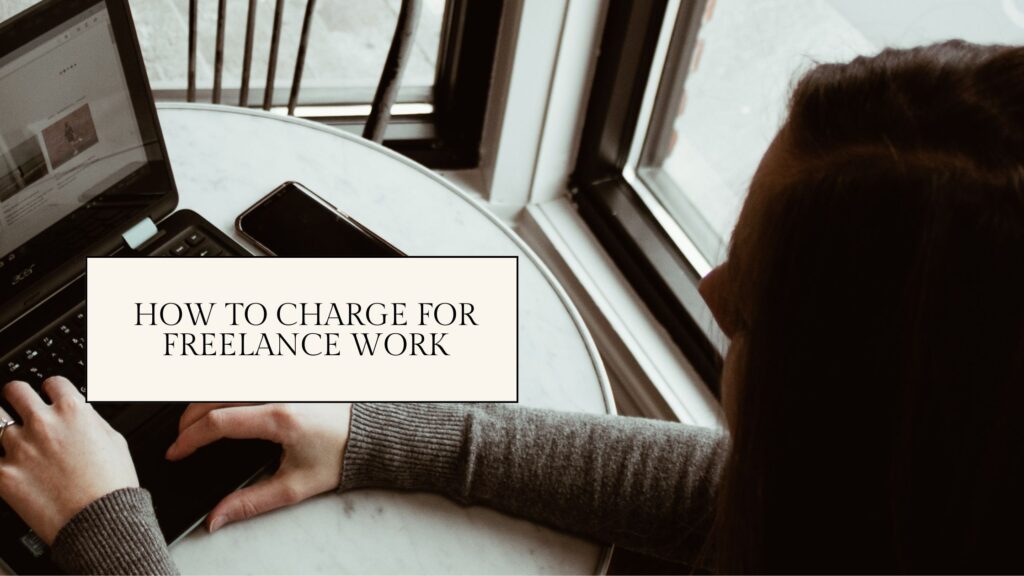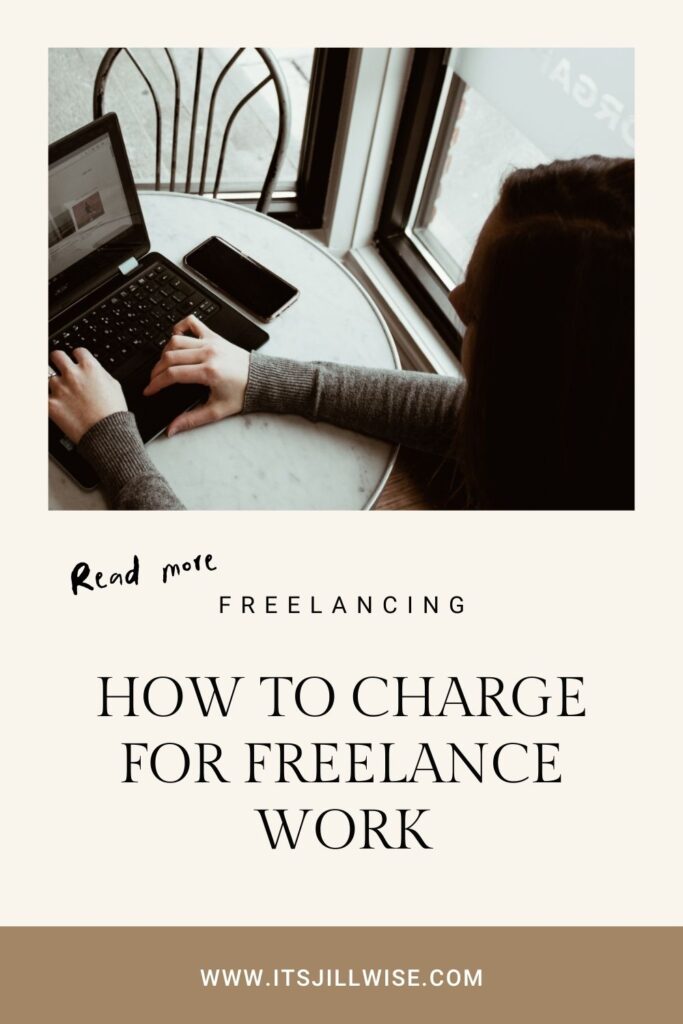A complete guide: How to charge for freelance work
“How to charge for freelance work?” … A question every new freelancer asks. If you’re new to freelancing, just know that even those who are more experienced still come back to this question from time to time. Every time you hit a new level in your freelance business, you’ll be faced with new challenges… But often, they come back to these foundational pieces, like how to charge for freelance work.
Why do so many freelancers get stuck here? Because there are so many things to learn outside from the freelance services you’re offering. The business side of things is where many creative freelancers struggle… How do you find clients? What process do you guide them through? How do you invoice them? How do you charge for freelance work after you’ve done the work?!
Freelance pricing models and how to decide what to charge
The unfortunate default for new freelancers is to undercharge at first in exchange for “experience” or “to get exposure” (I hate that word). But you’re not doing anyone any favours by being the person who can always do the job cheaper. And if you’re reading this, you might be lost about where to start and how it’s possible to grow your business with your current rates and pricing model.
In this post, I’m breaking down the different freelance pricing models, and why they work well… or don’t work well… By the end, you should know how to decide how to charge for freelance work you do for clients.

How to charge premium rates as a freelancer
If you’re feeling stuck in your freelance business, and just can’t seem to hit your revenue goals consistently… The problem may be your rates. Too many freelancers chronically undercharge for their work. This video walks you through 5 simple steps to raise your rates to expert-level status, and charge premium rates as a freelancer. It also covers why undercharging is bad for everyone, and factors to consider when determining your freelance pricing.
Watch this video for a step-by-step overview and a sneak peek of one of the most important conversations I have with my mastermind clients.
Why is undercharging bad as a freelancer?
I think you need the backstory to set the stage as to why I’m qualified to talk about how to charge for freelance work…
When I first started freelancing I was paid $25 to write 500 words. I pitched a ton of people to land this very first gig, and was so excited about it. Like cool, my first opportunity to get paid to write. Except it wasn’t that cool because this is INSANELY LOW. I would never recommend anyone work for such little pay. I kept this freelance writing job for over a year before I realized that I would never scale with rates like this. After expenses and taxes, I made less than minimum wage. Again, not cool.
For more context, this was back in 2014. That was before I knew people found clients on Instagram. I didn’t have a website or a community to ask questions. I didn’t have contracts or know how to invoice for the work I had completed… The list goes on! I had absolutely no idea what I was doing and didn’t know who to ask for help. That’s why it took me so long to grow to a spot where my business is my full-time career. But since I took so many wrong turns, I know a lot about what you should and shouldn’t do if you want to run a profitable online or freelance business. One of the most important things to avoid is undercharging.
Undercharging isn’t just bad for the underpaid individual though. There are so many reasons why freelancers need to charge dollar amounts that are fair for both themselves and their clients. Here’s just a few of those reasons…
Rate increases can be challenging to sell later
If you go in too low, it’s hard to bounce back. Rate increases are normal and expected in any business, but if you start off charging clients $X then one day tell them it’s going to be double or triple, you’re going to have to justify the increase well. Even if that’s what you legitimately deserve to be paid, they’ve already anchored your value next to your undercharge.
This is especially true if the actual service offer or package will remain the same. Why would they want to pay more for the same thing? If you’re in this spot right now, lead with the value in terms of results you can provide. For future clients, anchor your value at a fair rate.
The same is true for sales on services. You don’t want to discount your services too often (or at all) for two reasons:
- You might accidentally condition your audience to just wait for the next sale.
- You still have to do the same amount of work when you discount a service offer. A lower price tag should be a smaller scope or outcome.
I typically recommend not discounting services, especially if it’s 1:1 or done-for-you freelance work. The work that’s required is still the same, so why should there be a discount? Doing this will typically just lead to resentment from the freelancer, and a potentially disrupted working relationship because of that.
Freelancer rates dictate the value provided
Rates directly tie to quality of service. Why? Because you’ll have to squeeze in more work to make a living wage, which means less time allocated per project. You’re capable of better results, but keep setting yourself up for failure. With less time to spend on each project, the quality of your work will suffer. By charging more for freelance work, you grant yourself more time per project, which ensures you have enough space in your days to deliver exceptional client results… And avoid burnout.
Your rates also contribute to your perceived value. If you’re undercharging, some clients may wonder why. Sometimes it’s actually a red flag if a freelancer’s rates are too low. It leaves people questioning the results you provide. This is another reason why it’s important to anchor your value higher.
Revenue earned doesn’t equal income
You need to make a living. Sure, one-off projects and a bit of extra cash might seem fun at first, but what about the long game? Didn’t you start freelancing so you could replace your 9 to 5 income? Find freedom? Lots of us fall into the trap of undercharging to gain experience, but I bet you have bills to pay. Everyone deserves to make a living wage, so set your rates from the beginning to account for all the extras you’ll need to cover as a freelancer.
Undercutting the competition isn’t a long-term sales strategy
Think of your community. Community is so important for online business owners and freelancers. You don’t have to be friends with your competitors, but if you want others to respect you, you probably don’t want to be known as the one who low-balls everyone else in the community. Also, below-average rates devalue the industry as a whole because clients come to expect this. Nobody wins.
You will likely struggle with mindset. If you undervalue your work and others undervalue your work, where does that leave you? It’s likely that you won’t feel so great about yourself, that’s for sure! Especially not when you notice others charging way higher for similar freelance services.

Rethink your rates: How to charge for freelance work
Alright, I think I made it clear that undercharging is bad, but how do you go about actually setting rates for your freelance services? Unfortunately, this is difficult to explain in depth with a general blog post because there are so many nuances involved in setting rates, and every business is different. For hands-on support realigning and restructuring your services, offers, and the attached rates, you should check out The Inner Circle Mastermind. Your services suite is an entire pillar we cover both as a group and through 1:1 coaching and consulting. And we start with this pillar because it’s the foundation you need to grow your business.
However, I want to give you something to start with, so here’s an overview of things to consider when deciding what to charge for freelance work.
Freelance rates are different from in-house or corporate salaries
First, you need to forget everything you know about hourly wages. When you freelance, you don’t need to stay stuck in this box of payment for time worked. Also, it’s not going to equal the same amount of take-home income dollar for dollar if you compare freelance revenue to a corporate salary or in-house job. There’s way more factors to consider, and your revenue needs to be much higher than any income goals to account for this.
Instead of staying stuck in a per hour box, start to think about the value you provide. What ROI can you confidently offer your clients? How quickly you complete tasks shouldn’t be the only deciding factor. I’ve found that working with flat package rates is a lot more beneficial for everyone. Of course, I have a general understanding of how long things take in the business, both for myself and my team. But it’s cleaner this way, and I dedicate as much time as needed to each client without having to fit within a specific window.
Value-based pricing allows you to grow and scale your business in a much different way than doing the same work at an hourly rate, even if you were to still hire help.

Factors to consider: How to charge for freelance work
Industry averages for similar freelance work and roles
What’s the industry average for your type of freelance work? You’re going to need to do some research! What do other freelancers or service-based businesses charge for similar services? What’ i’s included in those rates? A lot of this information is available with a quick Google search and there are plenty of communities that share growing lists of what people charge.
What would an in-house employee in a similar position earn? Don’t take this number as final, but use it to create a range for yourself. Remember that full-time employees don’t need to pay business expenses or benefits like you have to now, so your billed hourly is always going to be higher than that average. A safe estimate is often 3x your desired take-home, but this isn’t a set rule! Again, there’s nuance to business and I hesitate to give generalized advice without that disclaimer.
Consider expenses and non-billable hours
Calculate your expenses and personal goals. What do you need to make in order to live comfortably in your city? What kind of money do you need to make to achieve the lifestyle you want? Set a goal for yourself and work backwards from there. For example, if you want to make $100k in a year as your income, you need to hit just over $8k of take-home pay each month. What does that revenue look like considering your expenses? Taxes? How many packages do you need to sell per month to reach that milestone?
Remember the non-billable hours. What are non-billable hours? The time you spend on admin, professional development, marketing, etc. Anything that isn’t directly tied to a paying client is non-billable, but should be considered when setting your rates. If you forget about these hours, you’ll end up working overtime for no pay to keep up with all the extras.
What results do you provide?
How much experience do you have? This includes full-time employee experience as well if your skills are transferable to your new offerings. Align yourself on the spectrum of new to seasoned, but also consider the results you provide. An “expert” doesn’t necessarily need to have worked in a field for a set period of time, but they should be recognized for the quality of work and outcomes they provide.
Of course as you gain more experience, you should raise your rates. However, remind yourself of the point above that is to not price yourself too low in the beginning.

How to charge for freelance work: Pricing models
As a freelancer, you’re actually running a business, which means that you get to dictate the terms of payment a lot of the time.
There’s a few ways you can charge for freelance work:
- Per word/deliverable
- Hourly rate
- Project flat rate
- Day reservation
- Results based
I never charge per word or per hour anymore, and typically recommend that others stop doing this ASAP. Although that’s where many people start, it’s not easy to scale and typically attracts low-paying clients, which makes it impossible to scale your freelance business. It doesn’t make sense either because the time it takes you to create something as a freelancer doesn’t necessarily reflect the results that deliverable can provide. And if you’re a freelance writer who charges per word, you might know that it’s actually harder to write using fewer words.
Instead, create packages or specific offers with set inclusions. Think of things like: Consultation hours, maximum deliverables, timelines for the agreement, etc. What additional services will cost outside of the proposed scope? What else goes into a project beyond just writing words?
How to charge for freelance work: Payment schedules
Beyond what dollar amount you charge for freelance work, there’s the question of when you can expect to get paid. So many freelancers are stuck in “feast and famine” and that really comes down to not controlling the cashflow of your business. This is where payment or fee schedules come in, and you get to decide that timeline.
There are a handful of ways you can structure payment.
- Project-based: For 1-time freelance projects, 50/50 is a popular payment schedule. Sometimes 50%, 25%, and 25% installments. The idea is you get a 50% deposit to secure the project in your calendar, and the remaining fees are due later. I prefer to make these fee schedules based on a set timeline rather than project milestones. This maintains cashflow even if there are project delays. For example, a client who takes longer to submit revisions will not be delaying your expected payment. Payment is due on the set date regardless of where the project is at.
- Retainer Fees: This is fairly self-explanatory. Retainer fees are typically due monthly before work commences. If you choose to grow a team within your freelance business, invoicing prior to the start of the month helps you maintain cashflow to pay your team accordingly. If they’re late, you can pause work. No more chasing clients for payments after the work is done!
- Pay in Full: This type of fee schedule is often required for smaller projects, consultations, or freelancer day rates. I personally have a minimum investment amount, and anything under this is expected to be paid in full. It’s easier for everyone involved.
Another popular way to charge for freelance work is using day rates. For a fee, clients can reserve you for an entire day to get through as many to-dos on their list as possible. I think VIP Days are a great addition to round out a services suite.

When should you raise rates as a freelancer?
Employees typically receive merit or performance-based raises on a set schedule, like quarterly or annually. Self-employed professionals should have the same opportunity for growth as well. If you’re booking farther and farther in advance, it’s time to raise your rates.
For example, I raise my rates in my business when I feel my offerings have grown to include more value. I also consider my experience and knowledge, my target clients’ budgets, the team involved in each project, and current industry standards for the services I provide. Just as I methodically set my rates in the beginning, raises are equally as calculated. As I can offer more value, I justifiably charge more. Through raising your rates, you may find that your target clients change slightly as well.
Summarizing how to charge for freelance work
If it weren’t clear yet, I believe in value-based, scalable pricing models for freelance work. I also think it’s important that freelancers realize they’re actually business owners. You have the potential to build a legitimate business… Not just make quick cash from landing gigs on the side. Take yourself and your business seriously by restructuring how to charge for freelance work in your business.
If you want 1:1 support with this, and eyes on your business in general, check out The Inner Circle Mastermind. This hybrid-style coaching and community is for other freelancers, copywriters, and marketers who want to build and grow a business that fits around their life… Because there’s more to life than working for the weekends. And you deserve to have everything you want from your work and life.

Related
Leave a Reply Cancel reply
Leave your info below to join. You'll be added to my email list, but can opt out at any time.

Thank you for sharing these valuable insights on charging for freelance work! You might also find this post helpful: https://blog.tmetric.com/how-to-set-billing-rates-for-freelance-projects/